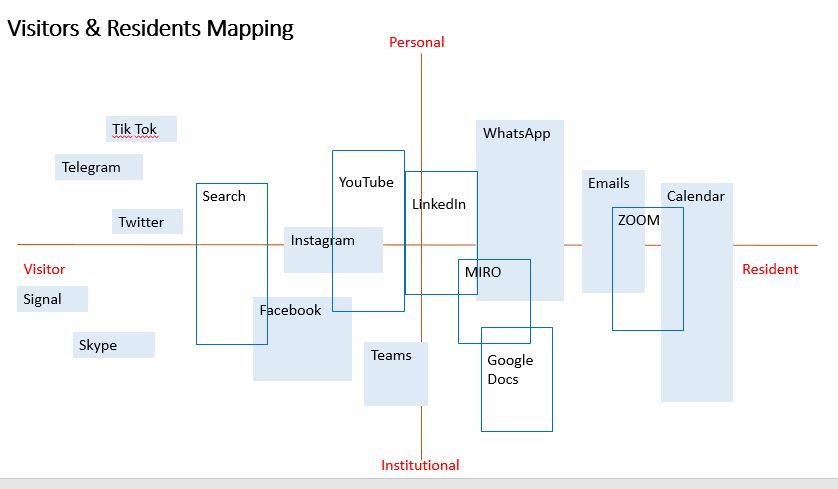Open Network Learning (ONL) topic 1 looks at online participation and digital literacies. Despite wishful thinking, I cannot be a digital native, but I have previously considered myself as an early digital migrant, having dabbled in this space since the turn of the century. Having heard the webinar from David White, I cannot help but agree that the terms digital native and migrants are already outdated given that they have been coined more than 20 years ago at the stage where the masses are starting to get online to the internet era.
Today, the term ‘digital’ is already passé. Ask any young student and you will get a blank look because there is no differentiation between digital and non-digital to them. I recall a time when I try to talk to my teenager while he is on his mobile. I insist that he prioritises our conversation because I am standing in front of him face-to-face, and so his mobile can wait. Obviously, he does not buy that argument because his friends are ‘online too’, and to him, virtual presence at the moment is as real and as important as someone physically present.
David White offers an interesting lens to view the different attitudes, beliefs and persona different people have with regards to online participation. Since age is not a determinant, he offers the view of visitors and residents, where visitors literally uses the online spaces as specific events or visits while residents choose to leave a part of themselves in online spaces to be connected to others. That role and relationship with online spaces can also be mapped from a personal or institutional perspective. An example below.

His mapping of visitors and residents effectively captures the relationship one has with online and is an interesting reflection and visual representation tool. I would consider to use his tool for some of my social media and digital marketing classes, and get students to reflect and consider where they are.
Besides this tool, our PBL05 team also went out to research on various aspects of digital literacies, specifically on the learning skills (blue), ICT literacies (red), and informational literacies (black).
You can check out our thinglink presentation here.
https://www.thinglink.com/scene/1427936896402587650
From a study with three higher education institutes in Scotland, Ireland and Greece (Martzoukou et al., 2020), it is found that digital literacies of students are related to their exposure and experiences in their daily lives. The more they are involved in experiencing digital interaction for their daily tasks, the more likely they will perceived themselves as being competent to handle digital literacies. For educators, possibly, we can consider providing opportunities for students to participate in online learning and team collaboration by re-designing our curriculum. Although this study focuses on higher education students, I believe that it can also be true for adult learners. From my observation from class, adult learners whose daily jobs involve dealing with software and applications usage, or online tools, transit a lot faster to online synchronous learning, as compared to those with limited exposure.
Moreover, it is important to note that students with higher digital competence also perform more digital informal learning (He & Huang et. al., 2020). This is especially important for adult learners, to keep their skillsets current, as the world of work changes and when organisations go through digital transformation.
As informal learning involves students’ control in their environment, digital competencies do matter. Whether students engage in digital information learning also depends on their attitudes, digital competence, perceived behavioural control, and perceived ease of use. Hence, it is important that the user experience of digital learning tools be useful and enjoyable for students in consuming the content and educators can play an important role here.
In fact, corporates like Microsoft is recognising value of informal learning beyond classrooms delivery. They have just announced an employee experience platform encompassing different aspects of learning. Viva Learning, provides opportunities for adult learners to discover and access resources relevant to their work, in one central location, aggregating learning content from various sources such as LinkedIn Learning, Skillsoft, Coursera and edX. This potentially changes in mode and format of learning to informal sources, and competencies in digital literacies play an even more important role in learning and development.
REFERENCES
White, D. & Le Cornu, A. (2011) Visitors and residents: A new typology for online engagement. First Monday, 16(9). http://firstmonday.org/ojs/index.php/fm/article/view/3171/3049
David White – Visitors and Residents Mapping
http://daveowhite.com/vandr/vr-mapping/
He, T., Huang, Q., Yu, X., Li, S. (2020). Exploring students’ digital informal learning: the roles of digital competence and DTPB factors, Behaviour & Information Technology, DOI: 10.1080/0144929X.2020.1752800
Martzoukou, K., Fulton, C., Kostagiolas, P., & Lavranos, C. (2020). A study of higher education students’ self-perceived digital competences for learning and everyday life online participation. Journal of Documentation, 76(6), 1413-1458. https://doi.org/10.1108/JD-03-2020-0041
Microsoft Viva Press Release
https://news.microsoft.com/2021/02/04/microsoft-unveils-new-employee-experience-platform-microsoft-viva-to-help-people-thrive-at-work/